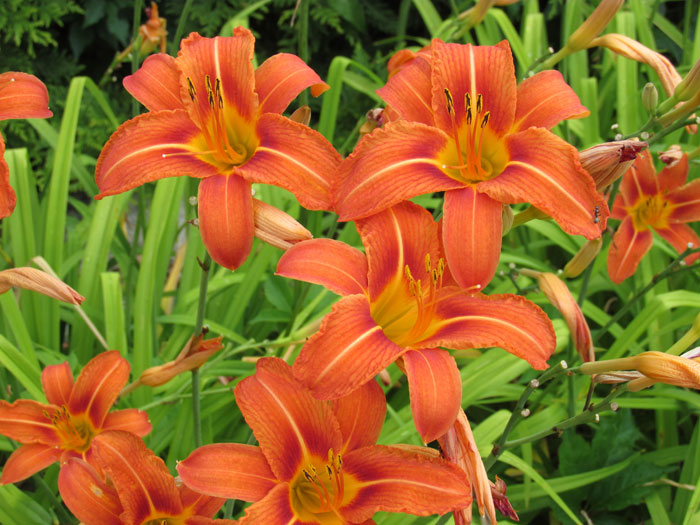What do ditch lilies and petunias have in common? Well if you live in Maine or any of the more northern states they are in bloom at the same time. We can grow day lilies, a relative, in Florida but they are often in bloom when the petunias are fading due to the hot weather and rainy days. But in the cooler north you can have both.
Ditch lilies are a favorite memory of many gardeners relocating to Florida. You may have called them tiger lilies or even outhouse lilies. They grow in clusters in the moist areas especially along the roadside. This year we reached Maine as the ditch lilies were beginning to decline but many were still opening their bright orange blooms.
Now here is a question. How were ditch lilies planted? Some references say they do not produce seed. So, did gardeners, dig, divide and replant the clumps we now see growing? They are not native. One resident did note they can produce aerial bulblets that might be washed about or carried and dropped by animals. Regretfully the memories of ditch lilies may only be revived and planted in more northern areas of Central Florida and above.
Petunias were coming into bloom and made for some of the bright pink, red, yellow and purple spots in local flower beds and container gardens. But there were many more flowers to enjoy too. At Prescott Park, home of an All-America Selections Gardens in Portsmouth New Hampshire, the coneflowers, zinnias, coleus and torenia bedding plant displays caught our eye.
A special feature was the hostas. They were at their height with many sending up spikes of familiar bluish blooms. Several selections had deep blue foliage and others variegated leaves. Don?t expect to plant these same memories locally but you can grow the peacock gingers and eucharis lilies with similar foliage in the shady sites. Yes, I do know we have a hosta or two that sort of grow here but not like in northern gardens.
Vegetable gardens were plentiful but a bit behind this year. One stop at a community garden with about 30 plots saw harvests of squash, lettuce, kale, peas, beets, onions and carrots occurring. One gardener noted the crops were later this year due to a cool wet spring. The corn was about 5 feet tall in most areas and needed a few more weeks until harvest time. The potatoes, which Maine is so well noted for, were starting to flower and form the under ground tubers.
One of our Florida favorites in bloom was the hydrangeas. It seems northern gardeners can grow them much better than most of us ? but we try. Their climate is more conducive to bigger and pest free plants. The blue selections had large cluster of flowers remaining and white snow ball types filled their plants to create a bright spot in the landscape. Yes, we do grow hydrangeas locally but it is a struggle. One trick is to do needed pruning by mid summer and keep the fungicide handy to control leaf spots and blemishes.
Dahlias were in bloom as was the liatris and shasta dasies. One favorite only more northern Florida residents can enjoy was the Queen Anne?s lace filling the roadside areas with white flower heads. It is a carrot relative that needs the cooler climate to mature and produce the blooms that invite the pollinators to visit. Queen Anne?s lace is native to Europe and Southwest Asia. Like the ditch lily, I wonder how it too became so well established in the northern states.
We brought clear days and warm weather to this northern state. It is kind of amusing how Maine residents feel 84 degrees is hot and almost unbearable while we fine it a relief and quite comfortable.

